Utah offers 5 national parks. Making it America's national park capital. All five parks are located in the famous red rock country of southern Utah. Each park offers its own unique display of natural wonders. From delicate red rock arches to deep canyon gorges, a visit to Utah national parks is sure to make a memorable and lasting impression.
Arches National Park
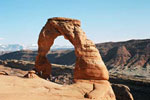 Arches National Park preserves over two thousand natural sandstone arches, including the world-famous Delicate Arch, in addition to a variety of unique geological resources and formations. In some areas, faulting has exposed millions of years of geologic history. The extraordinary features of the park, including balanced rocks, fins and pinnacles, are highlighted by a striking environment of contrasting colors, landforms and textures.
Arches National Park preserves over two thousand natural sandstone arches, including the world-famous Delicate Arch, in addition to a variety of unique geological resources and formations. In some areas, faulting has exposed millions of years of geologic history. The extraordinary features of the park, including balanced rocks, fins and pinnacles, are highlighted by a striking environment of contrasting colors, landforms and textures.
Bryce Canyon
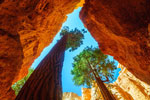 At Bryce Canyon National Park, erosion has shaped colorful Claron limestones, sandstones, and mudstones into thousands of spires, fins, pinnacles, and mazes. Collectively called "hoodoos," these colorful and whimsical formations stand in horseshoe-shaped amphitheaters along the eastern edge of the Paunsaugunt Plateau in Southern Utah.
At Bryce Canyon National Park, erosion has shaped colorful Claron limestones, sandstones, and mudstones into thousands of spires, fins, pinnacles, and mazes. Collectively called "hoodoos," these colorful and whimsical formations stand in horseshoe-shaped amphitheaters along the eastern edge of the Paunsaugunt Plateau in Southern Utah.
Canyonlands National Park
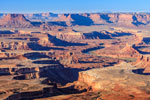 Canyonlands National Park preserves a colorful landscape of sedimentary sandstones eroded into countless canyons, mesas and buttes by the Colorado River and its tributaries. Located in southeast Utah, the park sits in the heart of a vast basin bordered by sheer cliffs of Wingate Sandstone. The Colorado and Green rivers divide the park into four districts: the Island in the Sky, the Needles, the Maze and the rivers themselves.
Canyonlands National Park preserves a colorful landscape of sedimentary sandstones eroded into countless canyons, mesas and buttes by the Colorado River and its tributaries. Located in southeast Utah, the park sits in the heart of a vast basin bordered by sheer cliffs of Wingate Sandstone. The Colorado and Green rivers divide the park into four districts: the Island in the Sky, the Needles, the Maze and the rivers themselves.
Capitol Reef National Park
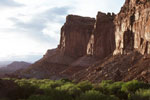 The Waterpocket Fold, a 100-mile long wrinkle in the earth's crust known as a monocline, extends from nearby Thousand Lakes Mountain to the Colorado River (now Lake Powell). Capitol Reef National Park was established to protect this grand and colorful geologic feature, as well as the unique historical and cultural history found in the area. From May to September, the park offers a variety of ranger-guided programs at no charge.
The Waterpocket Fold, a 100-mile long wrinkle in the earth's crust known as a monocline, extends from nearby Thousand Lakes Mountain to the Colorado River (now Lake Powell). Capitol Reef National Park was established to protect this grand and colorful geologic feature, as well as the unique historical and cultural history found in the area. From May to September, the park offers a variety of ranger-guided programs at no charge.
Zion National Park
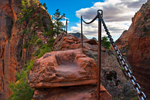 Zion National Park is world-renowned for its stunning scenery and claustrophobia-inducing slot canyons. But prior to becoming Utah’s first national park in 1919, it was rarely visited because of its remote location. The roads were awful and few automobiles could make it. Accessibility slowly began to improve when President Taft made the area a national monument in 1909. Of course, at that point it wasn’t called Zion National Park. It was known as the Mukuntuweap National Monument.
Zion National Park is world-renowned for its stunning scenery and claustrophobia-inducing slot canyons. But prior to becoming Utah’s first national park in 1919, it was rarely visited because of its remote location. The roads were awful and few automobiles could make it. Accessibility slowly began to improve when President Taft made the area a national monument in 1909. Of course, at that point it wasn’t called Zion National Park. It was known as the Mukuntuweap National Monument.